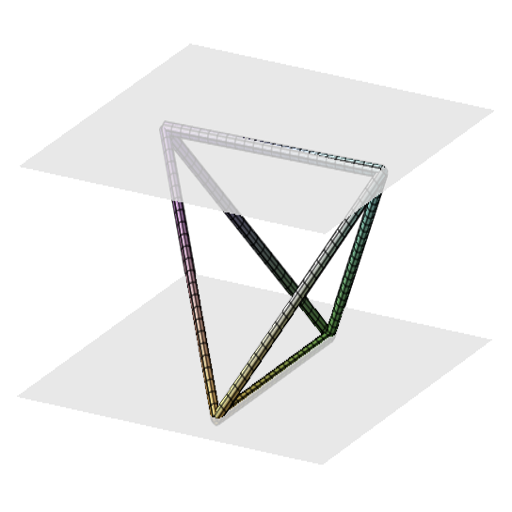I call our world Flatland, not because we call it so,
but to make its nature clearer to you, my happy readers,
who are privileged to live in Space.
~A. Square

In the past few years, you’ve probably heard something about graphene—whether as a replacement for silicon, as the next generation of organic solar cell, as the material in fast-charging batteries, or as one of the strongest materials ever discovered. There’s been so much hype that people have begun calling the flood of research and investment the graphene gold rush. In this post, I’ll give you a brief primer on the history of graphene, what graphene is, and why people are so excited about it. Next time, I’ll tell you a little bit about my own experience with graphene as an undergraduate student.
A Theoretical Exercise
Graphene was first discussed in 1946, by Canadian physicist Philip Russel Wallace. Wallace didn’t believe it was possible to make graphene; what he was interested in studying was graphite, the stuff in pencil lead. Graphite, a three-dimensional honeycomb structure of carbon atoms, was a bit too difficult to handle with the tools Wallace had available to him. Ever resourceful, Wallace invented a two-dimensional analog, graphene, from which he argued he could extract the properties of graphite.

Graphene is a two-dimensional grid of carbon atoms arranged in hexagons. Wallace showed that, if you stack enough sheets of graphene on top of each other, you get graphite. So he used his calculations for graphene to extrapolate information about graphite. Little did Wallace know that his theoretical material could actually be constructed in the real world.
Scotch Tape Makes it Real
In 2004, physicists Andre Geim and Konstantin Novoselov were playing with graphite cubes and Scotch tape. They would apply tape to a piece of graphite, then rip the tape off, pulling flakes of graphite with it. They did this again and again with the flaked-off graphite, separating it into thinner and thinner flakes, until (after ten or twenty or a hundred iterations), they ended up with graphite flakes only one atom thick. Materials don’t get any thinner than one atom thick, so this stuff was as close to two-dimensional as is physically possible. Geim and Novoselov had invented Wallace’s graphene.
Since then, many other groups have replicated Geim and Novoselov’s technique, called the “Scotch tape method.” You can even watch graphene being made this way on Youtube:
(It is debatable whether or not Novoselov and Geim were actually the first to use this technique, or even the first to discover graphene. Graphene historians–this is apparently a job now–have uncovered a fair number of earlier efforts. See the Wikipedia article for more details.)
Graphene Fever
Geim and Novoselov’s discovery made waves in the scientific community. Physicists were excited to test how the laws of physics changed if electrons were forced to live in two dimensions instead of three, so people put a lot of effort into understanding graphene. What they found was incredible.
Graphene’s unique band structure forces electrons in the material to always travel the same speed and never stop, no matter what’s happening to the material. This makes them behave a lot like light does in special relativity. It also means we can turn graphene into an absurdly good conductor that responds very quickly to an applied voltage. Even better, because graphene is so thin, it’s what’s called a transparent electrode: a conducting material that we can see right through. This is a huge deal! By the very nature of conductivity, things that can conduct electricity are usually opaque. However, graphene is so thin that it can’t possibly block, reflect, or absorb all the light that hits it.
Physicists have also discovered that the honeycomb structure of graphene’s carbon atoms is ridiculously strong. In fact, graphene is one of the strongest materials ever.
At this point, proposed applications for graphene started to appear everywhere. The gold rush had begun.
Some Words of Caution
Graphene made waves in the financial world as well as the scientific world. Many, many people have already invested in graphene-based businesses. And when there’s money at stake, people tend to oversell their ideas. This means that there are a lot of advertisements and publicity campaigns for graphene-based ideas that may not pan out.
Some commercial graphene ventures certainly will succeed. A few might even cause a sea change in technology. (And all commercial graphene ventures are cool.) However, you should take all the graphene hype with a grain of salt.
Related Articles
- One of the things that makes graphene so special is its band structure. I’ve written about band structure before, and you can find my article here.
- The band structure means that electrons in graphene behave like photons. You can see why that’s strange in my article on how the speed of light is constant.
That’s it for now. Next time, I’ll talk about my own personal experience with graphene.

I like how informal your articles are! more fun to read
Thanks, bash! I’m glad you liked it! 🙂
This is really helpful for my report!! thank you for making this! 🙂 Graphene really amazes me.
Thanks Megan! I’m glad it was helpful. Graphene amazed me too!
Thank you for all the information .
Graphene is amzing
I’m glad you liked it!